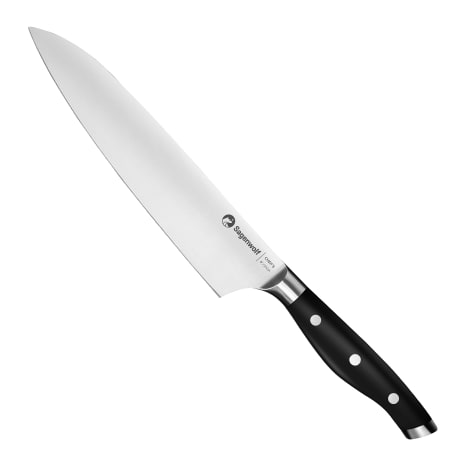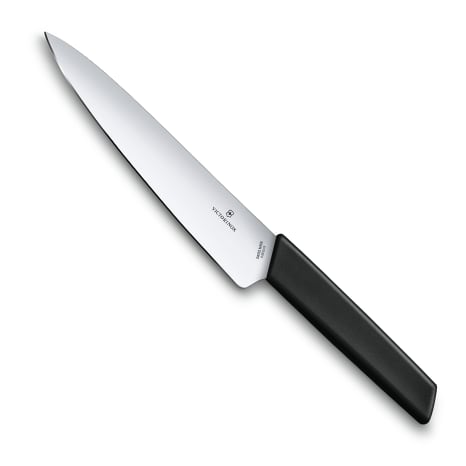–Get to know your knife!The anatomy of a knife 🔪
Ready to brush up on your knife knowledge? We’ve broken down the different parts of a knife, from the blade to the tang. Knowing your knife’s anatomy helps you know which features to look out for and to compare in your decision-making.
Check out the diagram below illustrating the anatomy of a knife, and we’ll walk you through the meaning of each of these key points.

Point: used for piercing and scoring. It’s an important feature of a boning knife.
Tip: the first third of the blade, used for fine, detailed slicing — for example, when mincing a shallot.
Blade: the main body of the knife and its size, shape and strength varies according to purpose. Edges can be straight, scalloped, serrated, single or double-bevelled. The oval depressions along the granton, often found on a santoku knife, hold pockets of air, which reduces sticking to the blade.
Edge: works hardest when you’re chopping and slicing. This area should be sharpened regularly.
Spine: can be held for better stability when finely chopping nuts or herbs, or for adding strength when slicing hard ingredients like butternut squash.
Heel: the strongest part and the optimum area to use for cutting through tough ingredients.
Tang: isn’t always visible, but adds strength and balance to the knife. It's the extension of the blade running into the handle — either all the way to the butt or only partially.
Bolster: The section between the handle and the blade — adds weight and counter balance between the blade and handle and can create a protective barrier.
Handle: as vital as the blade and can be made from plastic, wood or metal. It should be comfortable to hold, so try it before buying.
Most popular Knives
–Know your knife tangs
Now, you may have heard the terms ‘full tang’ or ‘partial tang’ and haven’t a clue what these mean.
The tang is the extension of the blade that runs into the handle of the knife.
Partial tang: this is where the extension of the blade extends into the handle of the knife but it doesn’t go all the way to the end, making it lighter to handle.
Full tang: this is where the tang runs all the way from the tip of the blade to the butt of the knife, giving it good balance and better leverage.

While full tang knives are known for their durability and balance, high-quality forged partial tang knives — especially traditional Japanese designs — can be exceptionally sharp, lightweight, and well-suited for precision tasks.
Full tang:
- Metal extends from the tip of the blade through to the butt of the knife
- Generally heavier, for better balance and leverage
- Strong and durable for heavy-duty tasks
- Fully forged construction preferred choice for professional chefs
- Ideal for heavy-duty tasks and general kitchen use
- Typically more expensive, but the durability and performance justify it for quality prioritisers
- Favoured by chefs needing a strong knife for tough kitchen tasks, ensuring longevity and reliability
Partial tang:
- Metal extends partway into the handle
- Lighter, making them easier to handle and guide
- Can be strong if well-forged, but may have weak points in lower-quality knives
- Often stamped rather than fully forged, resulting in a less robust construction
- Lighter and versatile for slicing fruit and veg
- Typically more budget-friendly compared to full tang knives
- Favoured for precision work, delicate slicing, general kitchen tasks
Most popular Knife Block Sets
–All about blade construction — stamped or forged?
Let's take a closer look at the basics of blade construction, looking at two main methods:
Stamped and Forged
Stamped: crafted by cutting out the blade from a large sheet of steel, then heat-treated. This process results in a lightweight blade, ideal for swift maneuvers.
Forged: created from a single bar of steel, undergoing repeated heating and hammering until achieving the desired shape and sharpness of the blade. This method produces a heavier, more durable blade because of the denser, more compressed metal — well-suited for robust tasks.
You may have also heard the term Fully Forged. Unlike stamped and traditional forged knives, a fully forged knife means the entire knife, including the blade, bolster, and tang, is meticulously crafted from a single piece of metal. This comprehensive construction ensures top-notch quality, durability, and balanced kitchen performance.
Stamped
- Cut from a large sheet of steel, then heat-treated and sharpened
- Lighter, easy to manoeuvre
- Less robust, may require more frequent sharpening
- More flexible, can bend under pressure
- Usually more affordable — easier to produce in large volumes
Forged
- Formed from a single bar of steel, repeatedly heated and hammered into shape
- Heavier, offers more control and stability
- Stronger, holds an edge longer — retains sharpness better due to denser steel
- Stiff and sturdy, less prone to bending
- Generally more expensive due to labour-intensive process
Most popular from the Wüsthof range
–Breaking down the bolsters
The bolster is like the bridge between a knife's blade and handle. It keeps the knife balanced and also shields your hand from accidentally touching the sharp part. It's an important part that makes sure the knife is both steady and safe to use.
Half bolster: the ridge junction doesn’t go all the way to the edge of the blade from the top of the spine, which allows for a longer cutting edge.
Ideal for: chopping, slicing, and other common tasks.
Full bolster: the ridge junction goes all the way to the edge of the blade from the top of the spine, giving better protection and heft.
Ideal for: heavy-duty tasks like chopping and slicing.
Butt bolster: the butt is that back end of the handle, a butt bolster is a thicker steel cap at the back of a knife for better balance, reinforcement and durability.
Half bolster:
- Its design reduces handle weight, offering a lighter, responsive feel for enhanced control and agility
- No bolster obstruction at the base of the blade makes sharpening more straightforward and efficient
- Reduced weight often results in improved balance, contributing to a more comfortable grip, minimising hand fatigue during prolonged use
Full bolster:
- Enhances balance and stability, providing better control during cutting tasks
- Can be tricker to sharpen, near the heel or edge of the blade
- Serves as a protective barrier, preventing fingers from accidentally reaching the sharp edge and enhancing overall safety
Most popular KAI Knives
Now that you've got the lowdown on knife anatomy, you can confidently choose the perfect knives to suit your kitchen needs. Happy chopping!



















